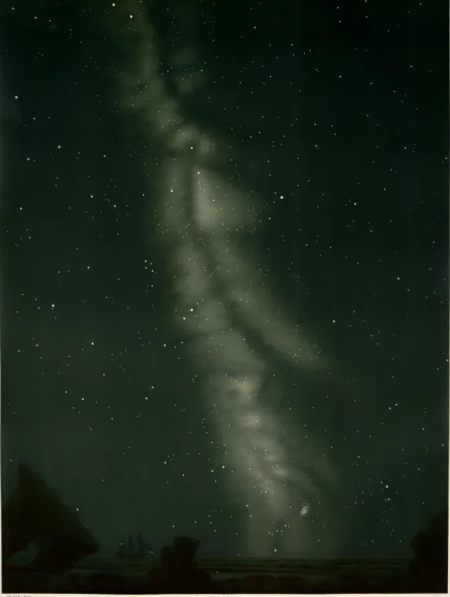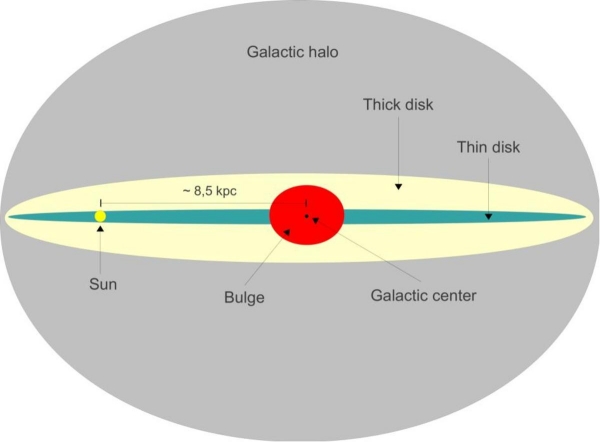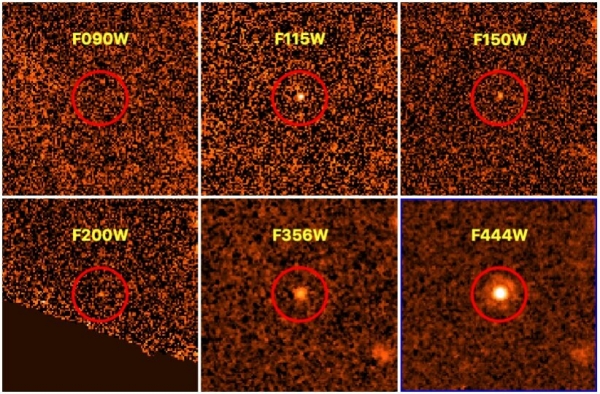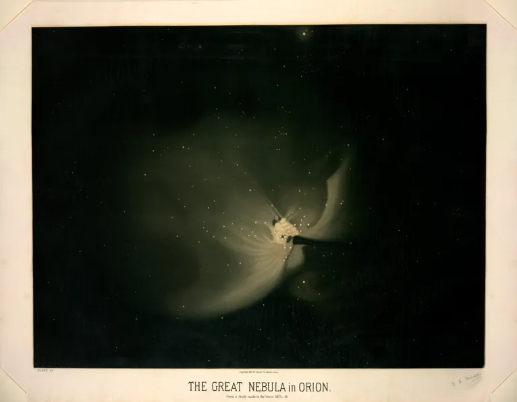I was getting ready to start writing a story with implications for brown dwarfs and the galaxy’s ‘thick disk’ (as opposed to its ‘thin disk,’ about which more in a moment) when I ran across the artwork below. This is the work of French artist and astronomer Étienne Léopold Trouvelot (1827-1895), whose careful astronomical observations were rendered into illustrations and pastel drawings in the era before astrophotography. I learned from Maria Popova’s The Marginalian that Trouvelot produced 50 scientific papers, but almost 7000 works of art based on what he saw. Thus the study of part of the Milky Way below, evidently created somewhere between 1874 and 1876.

Trouvelot’s work caught the attention of the director of the Harvard Observatory, who invited him to join its staff in 1872. The concept of his art was to get across to those without the privilege of seeing these objects through a telescope just how they looked to a trained scientist. He przed the value of human rendering over instrumentation, as in this passage from the introduction to The Trouvelot Astronomical Drawings Manual, published in 1882:
Although photography renders valuable assistance to the astronomer in the case of the Sun and Moon … for other subjects, its products are in general so blurred and indistinct that no details of any great value can be secured. A well-trained eye alone is capable of seizing the delicate details of structure and of configuration of the heavenly bodies, which are liable to be affected, and even rendered invisible, by the slightest changes in our atmosphere.
Thus the view from the 1870s. These days we explore the deep sky without the flourishes of a human pen through exquisite imagery from our Earth-based telescopes and space instruments like Hubble and JWST. But I always like to learn more about the development of our views of the cosmos, and wanted to introduce Centauri Dreams readers to a figure I only learned about over the weekend. I notice that Maria Popova is producing high-quality prints of some of Trouvelot’s work, with the proceeds benefiting an attempt to build a public observatory in New York City. A worthy project; I’m sure Trouvelot would have approved.
Brown Dwarfs and the Thick Disk
JWST’s early imaging has already proven stunning, and the discoveries mount. Today we look at a small object called GLASS-JWST-BD1, a member of that subclass of brown dwarfs known as T dwarfs. These are difficult objects to detect, with temperatures between 500 and 1500 K, and thus useful for exploring the boundary between star and planet when we can find them. What is exciting here is the demonstration of what JWST can do as we push outward in our observations of stars that cannot ignite hydrogen fusion, looking now into more distant parts of the galactic disk.
Objects like this emit primarily at infrared wavelengths. Their inherent faintness has meant that when we do surveys of brown dwarfs, we are working largely with brown dwarfs within 100 parsecs (326 light years) or less of the Sun. That has made it difficult to find such objects in the galaxy’s ‘thick disk,’ which consists of largely metal-poor stars rising well above the galactic plane. Surveys using the Hubble telescope’s WFC3 instrument have pushed detection further out but JWST’s results change the game.

Image: Edge on diagram of the Milky Way with several structures indicated (not to scale). The thick disk is shown in light yellow. Credit: Wikimedia Commons (CC BY-SA 3.0).
Indeed, the discovery paper puts the matter this way with reference to Hubble:
…these surveys are restricted to wavelengths < 2 ?m, limiting their sensitivity to the reddest and coldest brown dwarfs. The James Webb Space Telescope (JWST) represents a major step forward in the detection of cool and distant brown dwarfs, with imaging and spectroscopy extending to ? 5?m and providing orders of magnitude greater sensitivity than Spitzer.

Image: Using the James Webb Space Telescope (JWST), an international team of astronomers have detected a new faint, distant, and cold brown dwarf. The newly found object, designated GLASS-JWST-BD1, turns out to be about 31 times more massive than Jupiter. Credit: Nonino et al., 2022.
The work was led by Mario Nonino of the Astronomical Observatory of Trieste in Italy. GLASS-JWST-BD1 is between 1850 and 2350 light years from the Sun in a direction perpendicular to the galactic plane. Its mass is calculated at 31.43 Jupiter masses, with an effective temperature of 600 K. Its age is estimated at 5 billion years.
The discovery was made with JWST’s Near-Infrared Spectrograph (NIRSPEC) and Near-Infrared Imager and Slitless Spectrograph (NIRISS). We only have about 400 known T dwarfs to date, but it’s clear that JWST will expand the catalog substantially. What we’re seeing here is that JWST is able to probe out into the galactic thick disk to find objects that are small and faint, meaning that the study of brown dwarfs, their metallicity and the evolution of their atmospheres, will be considerably enhanced.
Backyard Brown Dwarfs
From an entirely different dataset comes brown dwarf news from the citizen science project Backyard Worlds: Planet 9, which has just announced the discovery of 34 binary star systems where a brown dwarf is a companion object to a white dwarf. Citizen scientist Frank Kiwy is in fact listed as lead author of the paper on these discoveries that appears in The Astronomical Journal. Kiwy’s work involved data mining within a database of 4 billion objects in in the NOIRLab Source Catalog DR2.
We have a long way to go in learning how common brown dwarf companions to stars are, but these are objects that merit attention for what they can tell us about atmospheres both stellar and planetary. Brown dwarf atmospheres contain interesting molecules and offer hints to the development of planetary atmospheres in gas giants.
Moreover, have you looked at the numbers of some of these citizen scientist projects lately? Backyard Worlds: Planet 9 has a network encompassing over 100,000 volunteers who scan telescope images to search for features that machine learning algorithms may miss. The binary systems Kiwy found were among a far larger group of 2500 potential ultracool brown dwarfs that appear in the NOIRLab data. So while JWST pushes the limits from L2, data gathering from more than 40 Earth-based instruments collected in the NOIRLab holdings is being combed by citizen volunteers.
Aaron Meisner is an astronomer at NOIRLab (National Optical-Infrared Astronomy Research Laboratory) and the co-founder of Backyard Worlds:
“These discoveries were made by an amateur astronomer who conquered astronomical big data. Modern astronomy archives contain an immense treasure trove of data and often harbor major discoveries just waiting to be noticed.”
Something tells me that Étienne Trouvelot would have liked the idea of an amateur making contributions worthy of professional publication. In any case, wouldn’t he have loved to have gotten hold of some of the views we’re seeing from JWST? It’s hard, though, to see how he could have crafted works of art more lovely than the Webb instrument’s recent deep field images. “[No] human skill,” he once admitted, “can reproduce upon paper the majestic beauty and radiance of the celestial objects.”
Nonetheless, his work is deeply attractive. Let me close with another, this one of the Orion Nebula.

The paper is Nonino et al, “Early results from GLASS-JWST. XIII. A faint, distant, and cold brown dwarf,” submitted to Astrophysical Journal Letters (preprint). The Kiwy paper is “Discovery of 34 Low-mass Comoving Systems Using NOIRLab Source Catalog DR2,” Astronomical Journal Vol. 164, No. 1 (6 June 2022). Abstract.



What would billions of artificial satellites orbiting a star do to its starlight? Would it turn red?
We have all that material in the asteroid belt plus the Kuiper Belt and the Oort Cloud. Could make a very interesting moving Dyson sphere…
The [trained] eye sees things that are not necessarily there, but rather the brain interprets the information based on experience and expectation. After all, wasn’t that the source of Lowell’s fanciful maps of Mars with its network of canals? Sir Patrick Moore once demonstrated that the eye adds connections between dots, with schoolboys shown a disk with random dark spots, one group of boys close, and the other farther away. The drawings of what they saw clearly demonstrated that the boys farther away drew lines between the spots, just as Lowell did (and Schiaparelli before him).
Compare Trouvelot ‘s painting of the Great Nebula in Orion with these 2 photos taken at the end of the 19th century and the beginning of the 20th. For all the beauty of the painting, the photos show better detail and are a closer reflection of reality, especially where observations for science are concerned.
<a href="photo 1901
“>photo 1881
photo 1901
Teasing out details of celestial bodies is better achieved using wavelengths of light that our eyes can respond to. The recent batch of the JWST infra-red photos demonstrates this beautifully.
As a schoolboy in the 1960s, we were taught how to draw what we see under a monocular microscope. (The key to doing this reasonably well is to keep both eyes open). Today, it is far easier and much faster to use a cellphone camera to take pictures at the eyepiece and use a paint app to label the parts. I cannot say that I bemoan the loss of drawing skills. For me, the artist is better at painting interpretations or imaginary scenes as the Astroartists do.
As devil’s advocate, there are still things that the scientist’s pen shows better than any photograph. For example, the Burgess Shale fossils.
But recall that Hallucigenia was completely wrongly characterized.
The dinosaurs as depicted at the Crystal Palace gardens by the Victorian era paleontologists we’re very wrong by even mid-20th century standards.
That’s a problem of interpretation, not observation. No machine would classify correctly a fossil.
Show 2 biological images where the pen pulls out more REAL detail than a photo. When I say REAL, I mean that subsequent analysis shows that it was not some visual artifact.
Artifacts have their place. Juno’s images of Jupiter are so detailed that I would use them to depict an extrasolar gas giant…because it looks so unlike the sepia tones of earlier probes.
There are lots of examples.
https://royalsocietypublishing.org/cms/asset/259d084e-cb0c-4d2c-870b-51d133a5f23a/rstb20140313f01.jpg
https://www.researchgate.net/figure/Dytikosicula-desmatae-gen-et-sp-nov-holotype-SM-X50203-1-photograph-dry-in_fig4_282437122
https://www.researchgate.net/figure/Interpretative-camera-lucida-drawing-of-Dytikosicula-desmatae-gen-et-sp-nov-compare_fig5_282437122
https://www.researchgate.net/figure/Wiwaxia-herka-sp-nov-1-holotype-KUMIP-287449-2-holotype-interpretative_fig6_282437122
I see what you are getting at. If you look carefully you will see very little added detail that is not visible even to an untrained eye. And note that the Dytikosicula interpretation drawing is just that, an interpretation. It is really little more than the outline of the fossil with some labels attached that may or may not be correct.
Now, look at this image that I prepared today with my Knightia fossil. The image starts with a classic top-lit image. The next shows the fossil with oblique lighting. Immediately the bone structure stands out, particularly the vertebrae [You can literally count the number by eye]. The last is the top-lit image, set to greyscale and inverted. Again, the bone structure is now much more visible.
Knightia image processed.
The point here is that even with a few minutes to change lighting and color process, details can be made to stand out that are not that evident in the standard top-lit imaging used. It really is no different from the false color imaging in astronomy to enhance details.
A recent post on fluorescence to show organic compounds is another technique. There are so many these days, from x-ray imaging to detection of the shapes of different color pigments that the crude drawings of what the observer sees in a fossil offer very little other than to highlight some features quickly and to map them to what we know from similar fossils, current evolved examples, and knowledge of structures that are used in cladistics. But as to really exposing details, imaging and analysis techniques are far better at extracting information even from fossils.
The paintings are exquisite. And useful at the time they were made. Of course modern imaging records reality more precisely.
Thank you Paul for including these drawings. An astronomical tradition that goes all the way back to Galileo.
I take it that his was a chance discovery of an object that just happened to be in the imaged field? Yes its great to get thick disk objects, but think what it means for other T and especially Y class brown dwarfs that are nearby and in the thin disk, especially in crowded low galactic latitude skies. This could result in a WISE like revolution of known near sol objects – including so called rogue planets. I’m looking forward to a few surprises and theres always the chance we might find something very cold nearer that A Cen.
P
When the first visitors from another star come, this is where the negotiations should be held.
https://dynaimage.cdn.cnn.com/cnn/q_auto,w_1100,c_fill,g_auto/http%3A%2F%2Fcdn.cnn.com%2Fcnnnext%2Fdam%2Fassets%2F170607153417-frank-lloyd-wright-2.jpg
Beautiful design that it is, it is not as structurally sound as it should be, having a number of flaws. ETs might not get the best impression of Earth’s technological capabilities from this house. Should they be heavy, it would not look good if the cantilevered floor structure collapsed.
Given that there will likely be some antipathy towards the aliens, the negotiation site should probably be both remote and defendable, with a place for any required landing craft to be reached quickly should the ETs need to make a rapid exit. But why should the USA be the best location? ;)
As beautiful as we may perceive FLW structures, I think its highly unlikely aliens will share our esthetic sensibilities. And as far as technical sophistication is concerned, I doubt if there’s anything we could do to impress them.
Besides, FLW structures reportedly have a tendency to leak when it rains.
I would choose the ESO hotel at the Paranal observatory.
Remote. Plenty of room for ET, and terrestrial negotiation and support staff. Space for any required landing craft. AFAIK, structurally more sound than Falling Water. It has it’s own esthetic, although we have no idea how ET would relate to terrestrial architecture. They may prefer being out in the open, or more comfortable in lightweight structures like tents, or even only feel secure within massive architecture or underground. We should certainly try to accommodate their environmental needs. More likely ET will prefer their own construction with a method to communicate with representatives. The movie Arrival (2016) strikes me as the more realistic approach.
The ESO Hotel is a much less intimidatory absent a foreknowledge of the provenance of the visitors. And the setting in proximity to the observatory is a not-so-subtle enhancement.
Let us follow the canals of Barsoom until we reach the red martian kingdom of Helium. Or at least ponder on the works of Italian astronomer Giovanni Schiaparelli and followers… The human mind’s ability to recognize patterns is amazing — especially when it goes awry.
While we’re on the subject…
I’ve noticed an alarming trend on TV documentaries about astronomy; very often artists’ conceptions and illustrations of astronomical objects are often show interspersed with actual imagery acquired by observatories or spacecraft sensors. For individuals familiar with the field, there is rarely any confusion, but for the layman, it is baffling.
The least they could do is insert a label, like “Artist’s Conception”.
And it leads to situations like this;
https://www.esquireme.com/news/planet-sized-chorizo-discovered-scientist
But that was a joke, even if it had some unfortunate consequences. More concerning to me is the illustrations of exoplanets. Usually, they are labeled as such, but not always. Like Hollywood, movies may be assumed to be fiction, but they do impress on the mind as real. So far at least, the astroart depicting landscapes from other planets and moons is not confused with reality, but the more the imagery looks less like a painting and more photorealistic, the less that distinction is made in the mind.
The larger picture is that it is becoming ever harder to distinguish real from fake. I recall a few years ago a movie about a casino heist in LV set in a building that looked absolutely real. I even looked at LV pictures to try to find it. Since then, CGI has become so good, that I don’t even bother. I just assume what is happening is faked because the destruction just cannot be real.
One day, an AI trained in Paul’s writing style will be writing these posts from the journal papers with Paul’s input from interviews, and we won’t be able to tell the difference between Paul’s and the AI’s parts…
It could well happen, Alex. A friend about 20 years ago commented on a column I had written for a computer magazine that in the near future, I would simply receive a topic from an editor and feed it into the appropriate program to generate my column. We both agreed that this would free up enormous amounts of time, and was a worthwhile project to consider. Does the Turing Test come into play in any of this? Has it already happened?
I’ll have an AI to read the columns your AI writes. It can excerpt and summarize what might interest me, and cross-reference previous columns and my comment history.
Of course more and more of the research and papers will be AI done and written, so we aren’t really needed at all!
In that case, Ron, we need to take up some new hobbies with our free time!
Rytr
My comment was triggered by a blog from a Berkeley professor of economics who had tested this site using
and receiving a passably coherent essay. It fell down on one keyword that showed it didn’t understand the concept. IMO, for teaching purposes, this really starts to change the game with regard to academic dishonesty.
Supposedly AIs already have been writing sports columns based on scores and other details. AI commentators have already remarked that GPT-3 and its ilk can write what seem to be decent articles if casually read, although fall down if examined closely. But we are only at the beginning. It is like suggesting that AIs could never beat a chess master, and then Kasparov was beaten in the 1990s. Sedol was beaten at Go by DeepMind’s Alpha Go, a game thought far too complex for an AI. These systems are only likely to get better. It would not surprise me if professional work output was handed to AIs, and that with some editing for mistakes was put forward as one’s own work. No more slaving over “the report must be on my desk tomorrow at 9 am, Mr. Smith”.
The ramifications for intellectual output in the workplace are going to be interesting. Will AI output be as accepted as spreadsheets and word processing for productivity, or will it shrink labor demand like the demise of secretarial pools? [I can imagine that [hack]scriptwriters could find their numbers dramatically reduced.]
There will likely remain the need for creative people to push forward our knowledge. For the rest, this might be a case of “the good enough, cheap product displacing the quality, expensive one” of The Innovator’s Dilemma.
I hope that these AIs will be good at creating first drafts that initially just need editing and customizing, a productivity booster for people like me that take far too long to craft anything. But eventually…
A slippery slope, though, Alex. Or to switch metaphors, the camel’s nose is under the tent once you let AI write a first-draft.
As I said, there are ramifications. As William Gibson said:
A fellow like me would promptly eat it up!
Computationally faking real persons speaking and acting.
Twenty years ago I used to worry that future historians would be piecing together our era out of fragments because so much would be lost as unrecoverable digital media. Today, I worry that we are planting fake fragments of our era.
In the 1960s, the BBC’s Quatermass episodic tv miniseries “Quatermass and the Pit” (1958) (followed by the movie and renamed in the US as Five Million Years to Earth (1967)) had Col. Breen believe that the buried Martian landing craft with the apemen skeletons and dead Martians were Nazi propaganda dropped during WWII. In 1993 the movie “Rising Sun” revolved around the use of faked security video to mislead the detectives about solving a murder. The UK’s Channel 4 just ran a miniseries “The Undeclared War” where fake videos constructed by the Russians and their “British” media enablers were used to mislead and distract the intelligence services at GCHQ from tracking down cyberwar hacks.
Scientists assume that nature is not out to fool them, which makes them very poor when examining phenomena like psychic powers. I don’t know how much more protected historians are at detecting faked evidence, especially if done at the time. [At least they know “Shakespeare” was a propagandist which is why Richard III is depicted as such a villain.] But how will far future historians be able to detect fake media content when it is so well made and the evidence of our times is so fragmentary?
What is the most up-to-date (2022) estimate for how common brown dwarfs are relative to main sequence stars?
HOW QUANTUM PHYSICISTS ARE LOOKING FOR LIFE ON EXOPLANETS
by Tanner Stening
August 17, 2022
The world that quantum physicists study with a trained eye is the very same world that we non-scientists navigate every day. The only difference is that it’s been magnified to scales incomprehensibly small and large.
Still, quantum physics remains largely a murky subject—even for scientifically astute readers. News@Northeastern spoke to Gregory Fiete, a physics professor at Northeastern, about some of the broad applications of quantum research, from developing renewable energy sources and building more powerful computers, to advancing humanity’s quest to discover life beyond the solar system. Fiete’s comments have been edited for brevity and clarity.
https://news.northeastern.edu/2022/08/17/quantum-physics-space-exoplanets/